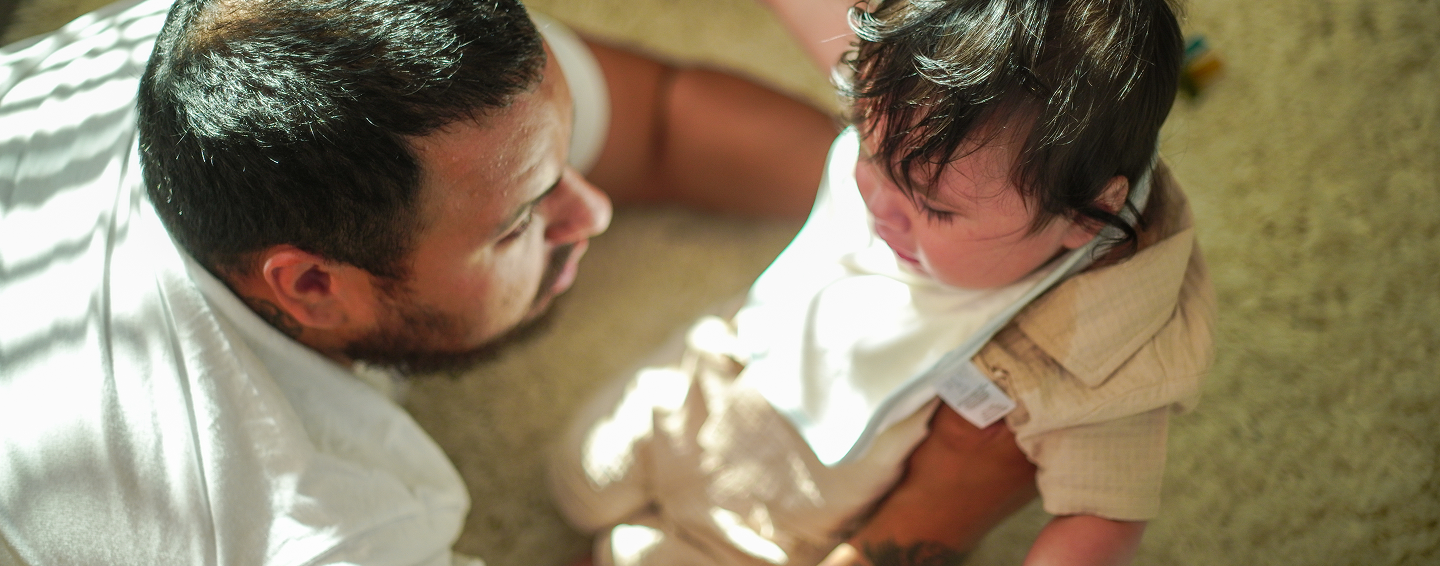Why Sleep-Deprived Parents Are Turning to Portable Solutions
A portable baby sleep aid is a battery-powered device that uses sounds, vibrations, or gentle lights to help babies fall asleep anywhere - from strollers to car seats to hotel rooms.
Quick Answer: Best Portable Baby Sleep Aid Options
- Clip-on sound machines - White noise with 10+ hour battery life
- Plush soothers - Heartbeat sounds in cuddly toys
- Stroller rockers - Gentle motion for on-the-go naps
- Mini projectors - Calming lights with nature sounds
- Smart wearables - Cry-activated auto-restart features
New parents get just 4 hours and 44 minutes of sleep per night during their baby's first year - that's 59% less than the recommended 8 hours. When your little one finally drifts off at home but wakes up the moment you step outside, portable sleep aids become a lifeline.
These devices recreate the womb environment your baby knew for nine months. White noise mimics the whooshing sound of blood flow that babies heard constantly before birth. Research shows 80% of babies fall asleep within 5 minutes when hearing familiar womb sounds.
I'm Gary Harutyunyan, and as a new father who struggled with my baby's sleep challenges, I invented the Sleepy Baby - a portable baby sleep aid that combines gentle patting with womb-like sounds. My experience helped me understand what overwhelmed parents truly need: reliable, safe solutions that work on-the-go.
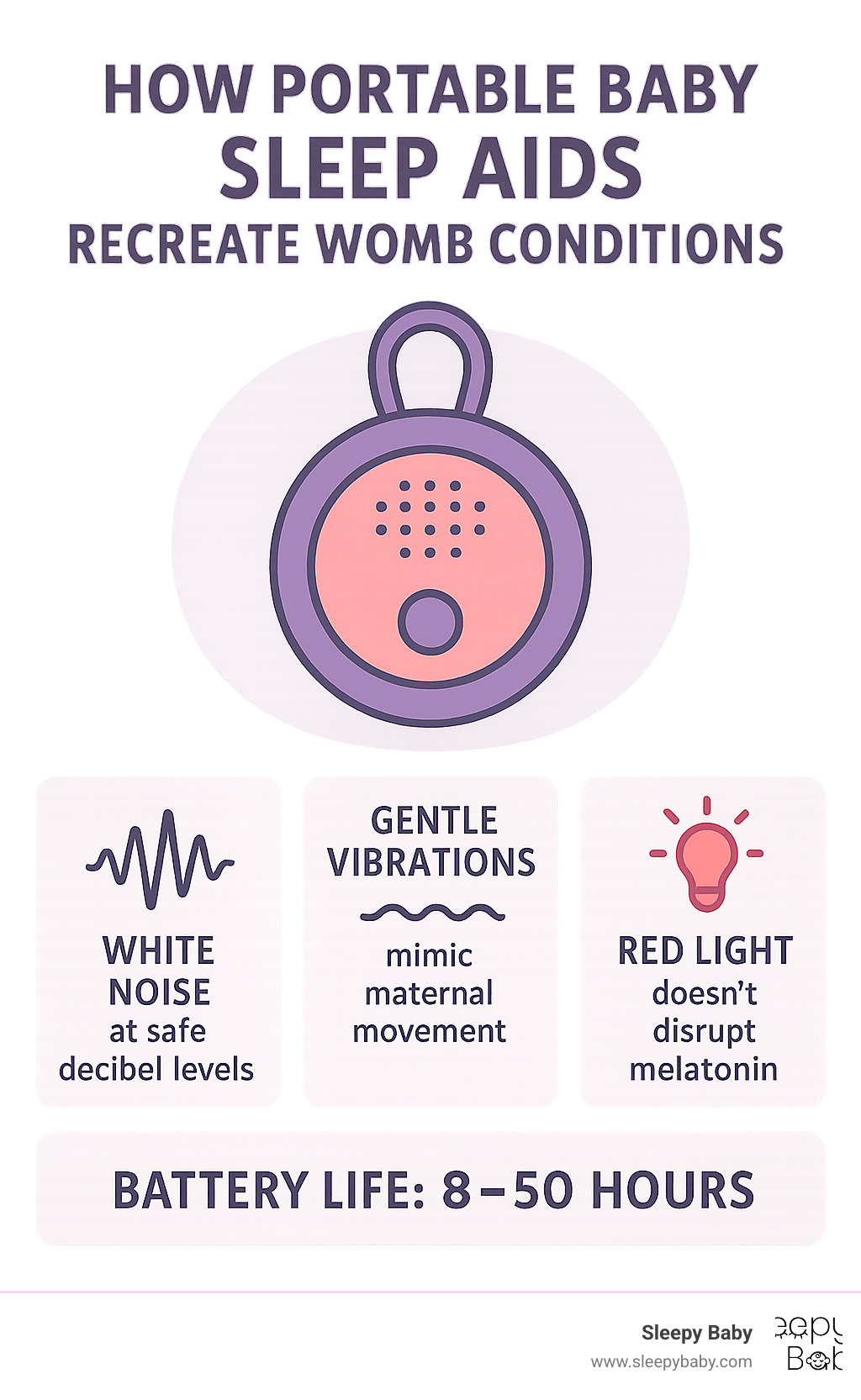
What Is a Portable Baby Sleep Aid & How Does It Work?
Think of a portable baby sleep aid as your baby's personal comfort zone that fits in your diaper bag. These devices combine the sounds, motions, and gentle lights that made your baby feel safe for nine months before birth.
At its heart, a portable sleep aid recreates white noise that mimics blood flow, soft shushing sounds, rhythmic heartbeat patterns, gentle vibrations, and red night lights that won't mess with sleep hormones. The real game-changer? These are battery-powered and clip-on, so they go wherever your baby goes.
Your baby spent nine months in a surprisingly noisy place. The whoosh of blood flow through your body, your heartbeat, and all the rhythmic motion from your daily activities created a constant, comforting soundtrack. The quiet outside world can actually feel strange and unsettling by comparison.
Scientific research on white noise and infant sleep backs this up completely. When babies hear familiar sounds, they settle faster and sleep more soundly because those sounds mask the sudden noises that might otherwise wake them up.
The Science Behind the Calming Reflex
When your baby hears womb-like sounds, their nervous system activates the calming reflex - basically their body's built-in "chill out" button that suppresses startling and drops stress hormones.
Every little sound - a door closing, a dog barking, even your footsteps - can jolt them out of peaceful sleep. White noise acts like a sound blanket, creating consistent background noise that prevents these jarring wake-ups.
The research is compelling: 80% of babies fall asleep within 5 minutes when they hear white noise, compared to just 25% in quiet rooms. It's not magic - it's biology working exactly as nature intended.
Recreating the Womb on the Go
The best portable sleep aids specifically recreate what your baby actually heard before birth - that distinctive whoosh of blood flow, steady heartbeat rhythms, and the gentle swooshing sounds that happened whenever you moved around.
Some devices add gentle vibration or motion, which works beautifully with swaddle techniques to create an even more authentic womb experience. The secret sauce is consistency - portable sleep aids let you maintain the exact same soothing environment whether you're at home or in an unfamiliar hotel room.
Top Portable Baby Sleep Aid Categories Parents Swear By
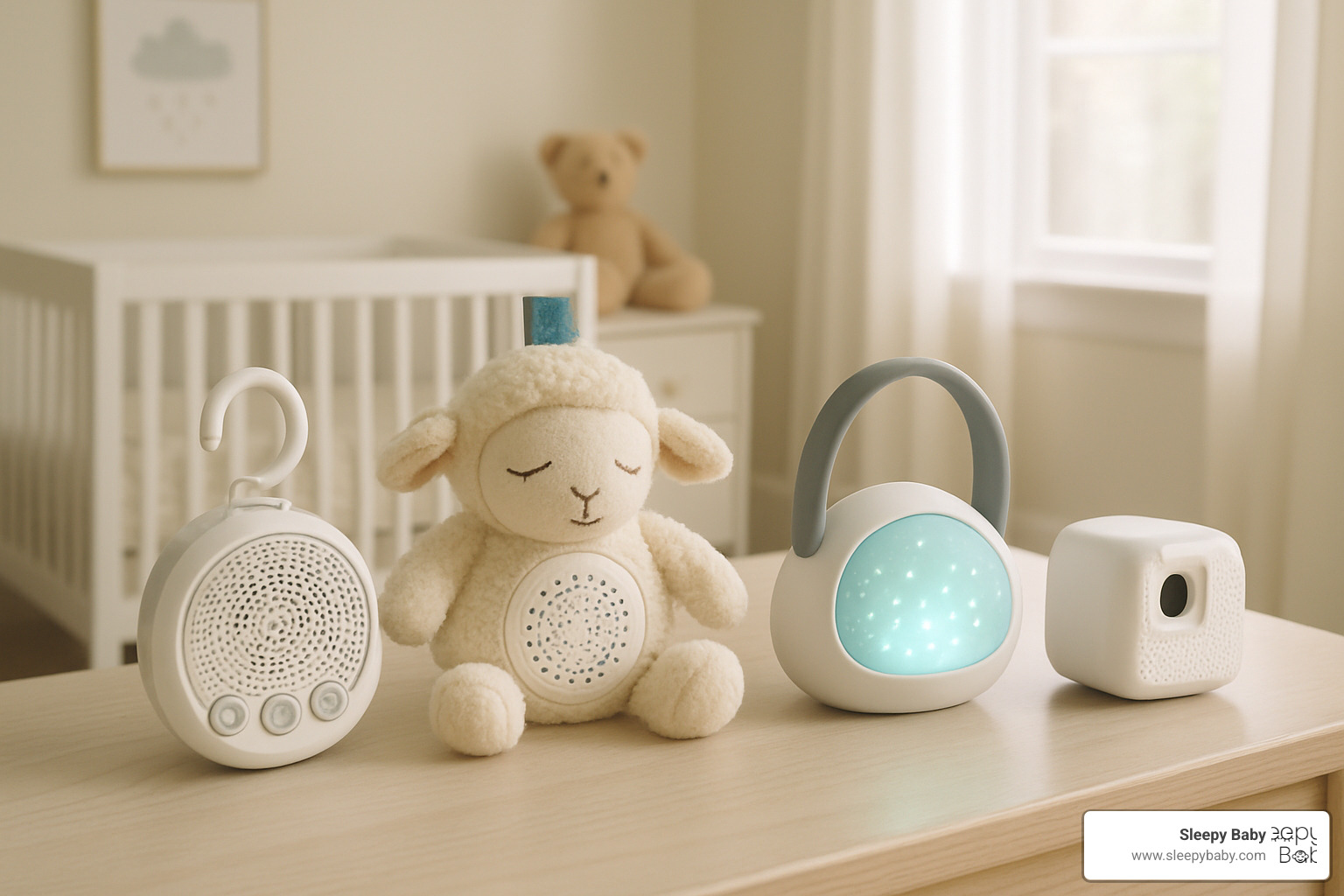
After talking with hundreds of parents and testing devices in real-world situations, five categories consistently rise to the top for their reliability and effectiveness.
Clip-On Sound Machine: The Classic Portable Baby Sleep Aid
The trusty clip-on sound machine packs serious soothing capability into a device smaller than your smartphone, typically weighing less than 5 ounces.
What makes them popular is their no-fuss reliability. Most quality models offer 8-10 different sound options, from classic white noise to nature sounds. The real winners include authentic womb sounds - that rhythmic whooshing your baby heard for nine months.
Battery life separates the champions from the disappointments. The best clip-on machines run for 15-20 hours on a single charge, while budget options might leave you scrambling for a charger after just 5-8 hours. Look for USB-C charging and the ability to play while plugged in.
Plush Multi-Sensor Buddy
These cuddly companions offer heartbeat sounds and pink noise (a gentler version of white noise) while providing the emotional comfort of a soft toy. The genius lies in their dual purpose - babies naturally form attachments to comfort objects.
Many models let you record your own voice - a 4-minute personalized message that plays when your little one stirs. The soft glow feature uses gentle LED lights that shine through the fabric, creating just enough illumination for nighttime comfort without disrupting sleep hormones.
Handheld Stroller Rocker
For parents whose babies are motion junkies, handheld stroller rockers are game-changers. These devices attach to your stroller handle and provide gentle, rhythmic motion even when you're standing still.
Most models are rechargeable and run for 2-4 hours continuously - perfect for extended outings. The better ones offer adjustable vibration patterns so you can find your baby's sweet spot for nap-on-the-move success.
Mini Light & Sound Projector
Mini projectors bring wonder to sleep time, casting gentle ceiling stars or slowly moving ocean waves while playing corresponding nature sounds. These compact devices transform any space into a calming sleep environment.
The secret weapon feature is red LED capability. Unlike other colors that can interfere with natural sleep hormones, red light provides gentle illumination without disrupting melatonin production.
Smart Wearable Soother
The newest players are smart wearables that monitor your baby's sleep patterns and respond automatically when soothing is needed. These typically clip onto clothing, using cry sensors to detect when your little one needs help settling.
What sets the best models apart is their ability to work independently. The real winners function perfectly without Wi-Fi or Bluetooth connections. This app-free use becomes crucial when you're traveling or dealing with connectivity issues.
Must-Have Features When Choosing Your Portable Baby Sleep Aid
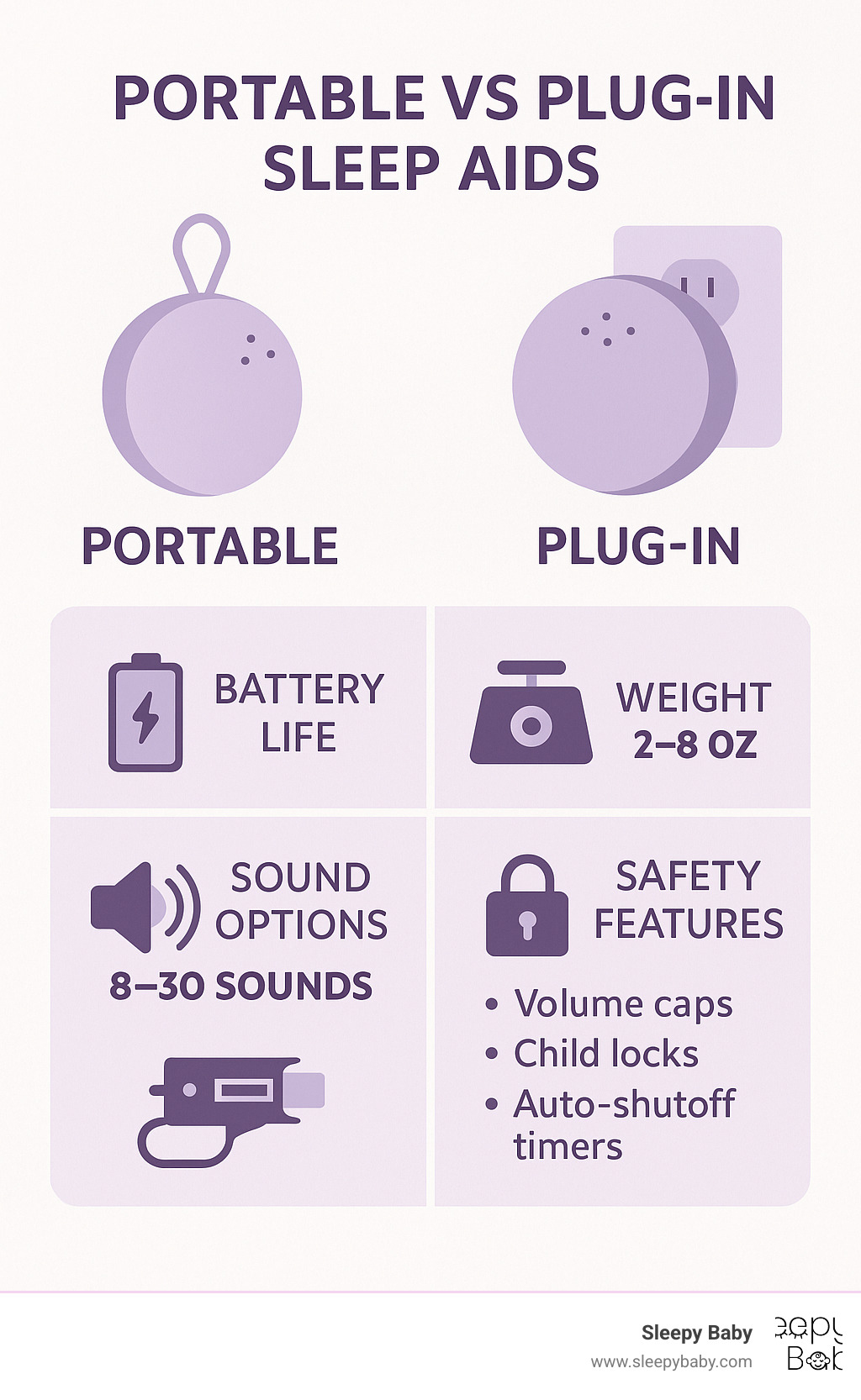
When investing in a portable baby sleep aid, certain features make the difference between a helpful tool and a frustrating gadget.
Sound quality should top your priority list. Premium devices use high-quality sound chips that produce rich, natural-sounding audio. Look for products that specifically mention "CD-quality audio" or "premium sound processing."
The safe volume cap isn't just nice-to-have - it's essential for protecting your baby's developing hearing. Quality devices automatically limit maximum output to 85 decibels or lower, which pediatric audiologists recommend as the safe threshold.
Battery life directly impacts usefulness during crucial moments when your baby finally falls asleep. Budget models typically offer 5-8 hours of play time, while premium options can run for 20-50 hours on a single charge.
Modern USB-C charging has become the gold standard. It charges faster than older micro-USB ports and you can use the same cable that charges your phone. Avoid devices with proprietary charging cables.
Lightweight construction matters more than you might think. The best clip-on devices weigh just 2-4 ounces, while effective plush soothers typically range from 4-8 ounces.
Secure attachment systems prevent the heartbreak of losing your device during outings. Look for multiple attachment options like clips, straps, and carabiners.
Timer options give you control over how long the device runs. Most quality units offer settings from 30 minutes to continuous play, with popular options at 1, 2, and 4-hour intervals.
Safety & Hearing Protection
The World Health Organization provides clear guidelines that continuous noise exposure for infants should not exceed 85 decibels. Following the "20-inch rule" - placing sound devices at least 20 inches away from your baby's ears - ensures safe exposure levels.
Child locks become increasingly important as your baby grows into a curious toddler. These locks prevent accidental volume changes or settings adjustments that could create unsafe noise levels.
Overheat protection is crucial for devices that run for extended periods, especially overnight. Quality manufacturers include thermal sensors that automatically shut down the device if internal temperatures exceed safe limits.
More info about safety in portable bassinets provides additional guidance about creating safe sleep environments when using portable equipment with your baby.
Battery Life & Power Options
Lithium-ion batteries offer the best combination of longevity, quick charging, and consistent power output. They typically charge to 80% capacity in 1-2 hours and maintain stable volume levels throughout the discharge cycle.
AAA battery compatibility provides backup power capability that can be lifesaving during extended travel where charging opportunities might be limited.
Play-while-charging capability eliminates the anxiety of running out of power during critical sleep times. This feature is absolutely essential for overnight use and long travel days.
Multi-Function Extras That Matter
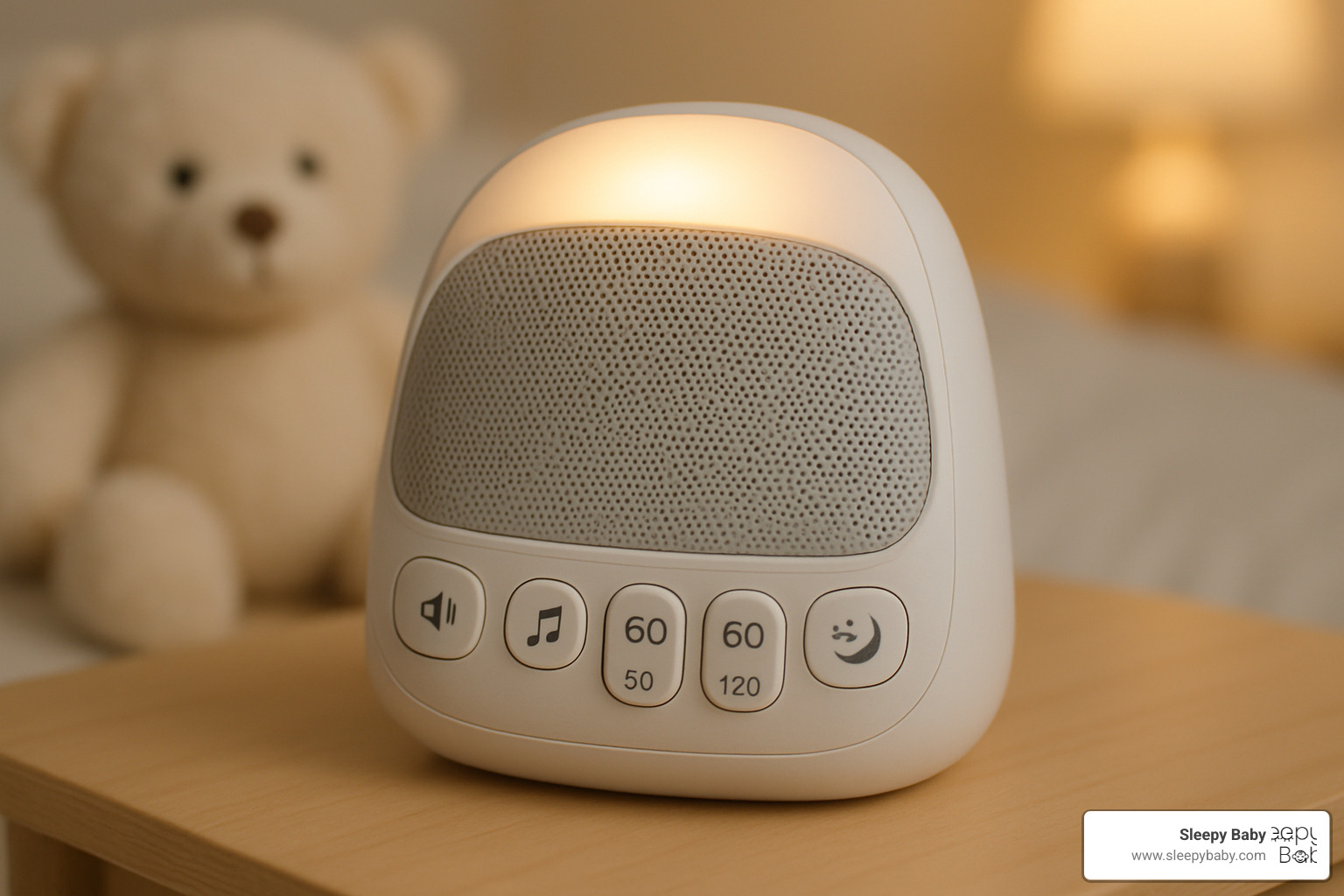
Record-your-voice features allow you to create personalized soothing messages that play when your baby stirs. Most devices allow 2-4 minutes of recording time, perfect for a short lullaby or gentle reassurance.
Red night light capability provides gentle illumination without disrupting melatonin production. Red light is the only color that doesn't interfere with natural sleep hormones.
Cry sensor technology automatically restarts soothing sounds when it detects fussing, providing intervention before your baby fully wakes up.
App-free operation ensures your device will work reliably even when smartphone batteries die or Wi-Fi connections fail.
Safe Use, Travel Hacks & Everyday Convenience
Life with a baby doesn't pause for nap time, and that's where portable baby sleep aids truly shine. Whether you're grabbing coffee while your little one snoozes in the stroller or trying to create a peaceful sleep environment in a noisy hotel room, these devices help maintain the comforting consistency your baby craves.
The secret to success? Start at home first. Let your baby get comfortable with their new sleep companion in familiar surroundings before you venture out. Most babies need about 3-5 days of consistent use to associate the sounds with sleep time.
More info about portable sleepers offers comprehensive guidance on creating flexible sleep solutions that adapt to your family's lifestyle.
Sleep Safety Guidelines for Newborns & Infants
Safety always comes first, and the American Academy of Pediatrics is crystal clear: never place portable sleep aids inside cribs or bassinets with sleeping babies. Instead, position your device on a nearby dresser, nightstand, or attach it to the outside of the crib.
Think of timers as your friend, not a limitation. Your baby doesn't need white noise playing all night long - 30-60 minutes for naps and 2-3 hours for overnight sleep is usually plenty. This approach helps prevent over-dependence while still providing the soothing support your baby needs.
Regular pediatrician visits should include conversations about your baby's hearing health, especially if you're using sound devices regularly.
Travel-Proofing Your Sleep Setup
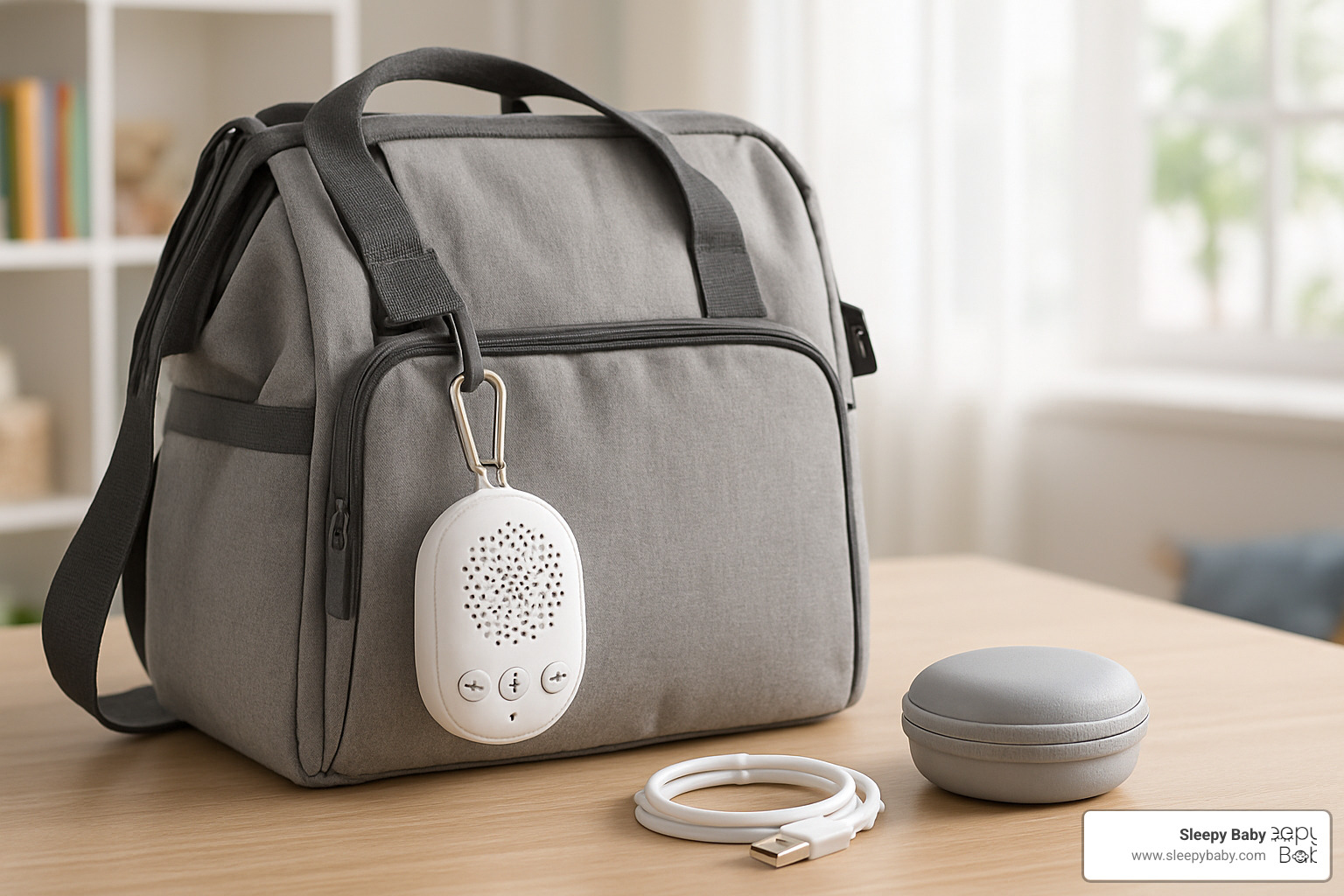
Organization is everything when traveling with a baby. Keep your portable baby sleep aid, charging cable, and any attachment accessories in one dedicated zip pouch within your diaper bag.
Battery anxiety is real, especially during long travel days. Pack a portable battery pack as backup power, and if your device takes AAA batteries, throw a spare set in your travel kit. Many seasoned parents charge their sleep aid every single night, just like they charge their phone.
Every new environment sounds different, so test your volume settings when you arrive somewhere new. That perfect volume level from home might seem too loud in a quiet hotel room or too soft in a busy relative's house.
Potential Drawbacks & How to Avoid Them
Like any good thing, portable sleep aids work best in moderation. Over-reliance can become problematic if your baby becomes completely unable to sleep without their device. The goal is to use these tools as a bridge to better sleep skills, not as a permanent crutch.
Starting with volume levels too high is a common mistake that can actually backfire. Your baby's hearing is much more sensitive than yours, so start low and increase gradually only if needed.
Nobody wants to face a dead battery during a sleep emergency. Develop simple charging habits like plugging in your device whenever you're home and not actively using it.
When it's time to gradually wean your baby off their sleep aid (usually around 6-12 months), take it slow. Reduce the volume by tiny amounts over several days, or shorten the timer duration gradually.
Remember to give those little ears regular breaks from sound. Plan at least one quiet nap per day, especially if you're using white noise for multiple sleep sessions.
Frequently Asked Questions about Portable Baby Sleep Aids
How long should I run a portable baby sleep aid during naps or overnight?
The timing depends on your baby's age and sleep patterns. For daytime naps, 30-60 minute timers work beautifully for most babies. This covers that tricky initial settling period plus one complete sleep cycle.
Babies naturally shift between sleep cycles every 45 minutes or so. The gentle white noise from your portable baby sleep aid helps bridge these transitions smoothly, so they drift back into deeper sleep instead of fully waking up.
Overnight use is more personalized. Newborns (0-3 months) often do well with 2-3 hour sessions that cover multiple sleep cycles. But once your baby hits the 6+ month mark, they might only need the soothing sounds during that initial settling period.
The all-night mode can be a lifesaver for babies who consistently wake up to every little household sound. But most healthy sleepers don't need it running all night long.
Are portable baby sleep aids safe for newborn hearing?
Yes - when used correctly, portable sleep aids are perfectly safe for your newborn's delicate hearing.
The magic number to remember is 85 decibels or lower. Quality devices automatically cap their volume at this level. But volume is just part of the equation - distance matters too. Keep your device at least 20 inches away from your baby's ears.
Here's a simple test: if you can't have a normal conversation over the white noise, it's too loud. The sound should be noticeable and consistent, but not overwhelming.
Regular breaks from continuous sound are also important for healthy hearing development. This is another reason why timer settings work better than all-night continuous play for most families.
Can I keep using a portable sleep aid as my child grows older?
Absolutely! Many families successfully transition their portable baby sleep aid from newborn days all the way through toddlerhood.
Toddler sleep challenges are often different from baby sleep issues. Instead of frequent night wakings, you might be dealing with bedtime resistance or sensitivity to household noises during afternoon naps. White noise continues to be incredibly helpful for masking those random sounds.
As your child grows, toddlers can learn to associate their familiar sleep sounds with bedtime routines. Some parents use it as a "sleep cue" - when the white noise starts, it's time to settle down.
The gradual phase-out approach works best when you're ready to transition away from the device. Most families find the sweet spot for weaning is somewhere between ages 2-4, depending on their individual child's sleep maturity.
Conclusion
Finding the right portable baby sleep aid can feel overwhelming when you're running on four hours of sleep and your baby only naps in your arms. But these little devices really can give your family the freedom to live life beyond the nursery walls.
The science backs up what desperate parents have finded through trial and error. When 80% of babies fall asleep within five minutes of hearing familiar womb sounds, and new parents are surviving on less than five hours of sleep per night, portable sleep solutions aren't just convenient - they're essential for family wellbeing.
What matters most isn't finding the fanciest device with the most features. It's choosing something safe, reliable, and suited to your family's specific needs. Whether that's a simple clip-on sound machine for stroller walks or a smart plush toy that responds to your baby's cries, the best portable baby sleep aid is the one you'll actually use consistently.
Safety features like volume caps under 85 decibels, secure attachments, and child locks aren't negotiable. Battery life between 8-50 hours gives you flexibility for different situations. And sound quality that actually soothes rather than irritates makes the difference between a helpful tool and an expensive paperweight.
At Sleepy Baby, I created our portable sleep aid after experiencing how isolating it feels when your baby only sleeps with constant motion or touch. Our device combines proven white noise with gentle rhythmic patting that mimics a caregiver's comforting hand. This hands-free approach means you can grab coffee with friends, attend family gatherings, or simply take a shower while your baby gets the soothing they need.
Every baby is wonderfully unique. What sends your friend's baby into blissful sleep might leave yours wide-eyed and curious. The beauty of portable sleep aids is their flexibility - you can experiment with different sounds, timer settings, and placement options until you find your baby's perfect sleep recipe.
These devices are bridges, not permanent solutions. As your little one grows and develops stronger sleep skills, your trusty sleep aid can transition from daily necessity to occasional travel companion.
Sweet dreams really are possible, even when you're not at home. With the right portable sleep aid and proper usage techniques, you can give your family the gift of better sleep wherever your trips take you.
More info about portable baby sleep solutions provides additional guidance for creating flexible sleep environments that support your family's active lifestyle.


